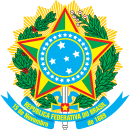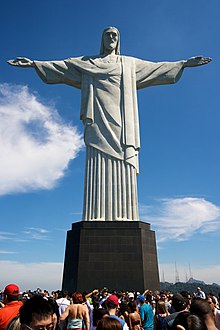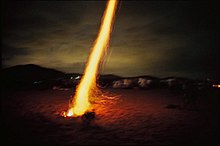Brazilian art

| Part of a series on the |
| Culture of Brazil |
|---|
 |
| Society |
|
| Topics |
|
| Symbols |
The creation of art in the geographic area now known as
Pre-Columbian traditions
The oldest known art in Brazil is the cave paintings in Serra da Capivara National Park in the state of Piauí,[1] dating back to c. 13,000 BC. More recent examples have been found in Minas Gerais and Goiás, showing geometric patterns and animal forms.[2]
One of the most sophisticated kinds of Pre-Columbian artifact found in Brazil is the sophisticated
In the beginning of the 21st century, the ancient Indian traditions of body painting, pottery, cult statuettes, and feather art are still being cultivated by the remaining Indian peoples.
-
Cave paintings, Serra da Capivara National Park.
-
Shark-shaped carved stone, Sambaqui culture, Museu da Universidade Federal do Rio Grande do Sul.
-
Burial urn, Marajoara culture. American Museum of Natural History.
-
Santarém culture. Museu Paraense Emílio Goeldi.
-
BororoIndian with feather headdress and body painting.
-
Tikuna ceremonial dresses. Memorial dos Povos Indígenas.
-
Tiriyó-kaxuyana beadwork. Memorial dos Povos Indígenas.
-
Enawene-nawebody-art.
Baroque
The first Western artists active in Brazil were
Through the 17th and 18th centuries Baroque art flourished with increasing richness and craftsmanship, mainly in
-
José Joaquim da Rocha: Painted ceiling of St. Dominicus Church, Salvador
-
Ricardo do Pilar: Man of sorrows, c. 1690
-
São Francisco Church, Salvador
-
João Nepomuceno Correia e Castro: Immaculate Conception. Museu da Inconfidência
-
School of Bahia: Christ the Savior.
-
Ataíde: Our Lady surrounded by musician angels, Church of Saint Francis of Assisi, Ouro Preto
-
Aleijadinho and Francisco de Lima Cerqueira: Church of Saint Francis of Assisi, Ouro Preto
-
Aleijadinho: Christ praying, Bom Jesus de Matosinhos Sanctuary
19th century: Neoclassicism, Romanticism, Realism
One single event in the 19th century sowed the seeds for a complete renewal in Brazilian visual arts: the arrival of the French Artistic Mission in 1816, which strongly reinforced the Neoclassical style, previously seen in Brazil only in timid attempts. Joachim Lebreton, its leader, proposed the creation of an Academy of Fine Arts, later restructured as the Imperial Academy of Fine Arts. The academy was the most important center for the visual arts through nearly the whole of the 19th century. It imposed a new concept of artistic education and was the basis for a revolution in Brazilian painting, sculpture, architecture, graphic arts, and crafts.[7] A few decades later, under the personal patronage of Emperor Pedro II, who was engaged in an ambitious national project of modernization, the academy reached its golden age, fostering the emergence of the first generation of Romantic painters. Victor Meirelles and Pedro Américo, among others, produced lasting visual symbols of national identity. It must be said that in Brazil Romanticism in painting took a peculiar shape, not showing the overwhelming dramaticism, fantasy, violence, or interest in death and the bizarre commonly seen in the European version, and because of its academic and palatial nature all excesses were eschewed.[8][9][10]
Meanwhile, literature too evolved towards a romantic-nationalist school with the works of
In music, the 19th century produced only two composers of outstanding talent: neoclassical sacred composer José Maurício Nunes Garcia, for a while music director to the court, and later, Romantic operist Carlos Gomes, the first Brazilian musician to win international acclaim.[12]
In the late 19th century, Brazilian art became acquainted with
-
Simplício de Sá: Portrait of Peter I, ca. 1830. Imperial Museum
-
São Cristóvão, Rio de Janeiro
-
Belém do Pará
-
Victor Meirelles: The first Mass in Brazil, 1861. Museu Nacional de Belas Artes
-
Rodolpho Bernardelli: Christ and the adulterous woman, 1881
-
Almeida Junior: Model's rest, 1882. Museu Nacional de Belas Artes
-
Nicola Facchinetti: Rodrigo de Freitas lagoon, ca. 1884
-
Belmiro de Almeida: Effects of sunlight, 1893
20th century: Modern Art

The beginning of the 20th century saw a struggle between old schools and modernist trends. The

The Week not only introduced to a wider public modern, experimental tendencies derived from European Expressionism, Cubism, and Surrealism, but also wanted to make use of national folklore as a basis for an art more relevant to the Brazilian reality, with an enhanced social awareness. This "cannibalization" of European movements and transformation into genuine Brazilian expression is the motto between the Anthropophagic Manifesto, published by Oswald de Andrade in 1928, that draws parallels between art history and the cannibal rituals of the Tupi people.
However, the radicalism of those first Modernists couldn't last for long in a society used to traditional fashions, and the original core members had separated by 1929, pursuing individual paths. What Brazilian art then became was a mix of some important achievements of the Moderns, meaning freedom from the strict academic agenda, with more conventional traits, giving birth in the following generation to a moderate Modernism, best exemplified by painter

Within the group of Brazilian artists, Chico Niedzielski's artwork has been spread all over the country. His work is known to be inspired by Sacred Geometry, breaking the tendency to focus on Brazilian themes and searching for a more universal and atemporal form of Brazilian art. The erosion of radical Modernism in the visual arts in the early 20th century was not reflected in Brazilian literature.
1960s onwards: Contemporary Art
Around the 1960s, the so-called "modernist" art movements started giving way to most contemporary means of expression, such as appropriation, political art, Conceptual art and Pop. Right at the turn of the decade, some Brazilian Concrete artists began ditching the traditional "strictness" of concrete art in favor of a more phenomenological approach, exploring the relations between the art object and the viewer. Among the primary leaders of this Neo-Concrete movement were the poet Ferreira Gullar, and the visual artists Hélio Oiticica, Lygia Pape and Lygia Clark, this last one internationally cited as one of the most influential artists of the 20th century.[16]
The Coup d'état of 1964 and subsequent restriction of civil rights and freedom of expression in Brazil is commonly marked as the shifting point, whence artists such as Cildo Meireles and Rubens Gerchman began creating explicitly political art.[17] Particularly after 1968, when the military government legalized torture, Brazilian art was marked by rather radical actions and happenings. The São Paulo Art Biennial, the second oldest art biennial in the world, opened up with most of its walls empty due to a boycott from the artists.[18] In 1970, the exhibit Do Corpo à Terra ("From Body to Earth") took place in Belo Horizonte, and included rather shocking actions such as Cildo Meireles setting live chickens on fire in front of a live audience[19] and Artur Barrio ditching blood-soaked packages in a river, giving off the impression that the people who disappeared under the military government had "reappeared" in this gruesome fashion.[20]

Brazilian Pop art didn't come without its share of criticism, sometimes adopting an outright rejection of consumer culture instead of the ambivalent, distant criticism of American pop. Waldemar Cordeiro is one of the most expressive artists that began exploring digital art and robotics in its work around the 60s and 70s, while Antonio Dias, Carlos Vergara brought the aesthetics of comic books, playing cards and other popular forms of visuality into his work. Hélio Oiticica's "Tropicália", a colorful immersive installation piece, incorporated references to the slums of Rio de Janeiro. The title relates to the cultural movement of the same name, that called back to the Antropophagic Manifesto of the 1920s to offer a more tongue-in-cheek perspective on the myths of an exotic and "wild" Brazil.
Some artists as: Hélio Oiticica, Lygia Clark, Naza, Cildo Meireles among others, have been featured on the international stage. Brazilian contemporary art and photography are among the most creative in Latin America, growing an international prominence each year with exhibitions and publications. Brazilian contemporary photographers include Miguel Rio Branco, Vik Muniz, Sebastião Salgado, and Guy Veloso.[citation needed]
Indigenous Artists
The Pinacoteca de São Paulo museum has become the first museum in over 100 years to host a contemporary Indigenous art exhibition.[21] The exhibition is featured 23 Indigenous artists from various ethnicities across Brazil. The Véxoa exhibition showcases paintings, sculptures, videos, photographs and installations[22] all with the political goal of capturing and drawing attention to important issues currently affecting the Indigenous population, which come in the form of agribusiness, deforestation, illegal mining and climate change.[21]
The name of the Véxoa originates from the Terena language and translates to "We Know."[22] The exhibition aims to break stereotypes surrounding Indigenous communities in Brazil. The curator of the museum has chosen a variety of Indigenous works which are both contemporary and traditional. The museum includes a diversity policy but does not group indigenous group the artist by ethnicity or chronological in order to emphasize the universalism of shared experiences by the native communities as more than 300 Indigenous group currently reside in Brazil according to Olinda Yawar.[21] The exhibition include Indigenous film, photography, ceramics, embroidery and natural materials.[22]
Ailton Krenak a leading Indigenous artist and philosopher has talked about the exhibition as "an opportunity to expose the extremely adverse times that Indigenous people are experiencing as a result of political violence perpetrated against their rights by the Brazilian State."[21]
Yakuña Tuxá an Indigenous female artist from Bahia has put forward multiple artworks that reflecting the challenges of being an Indigenous woman in modern-day Brazil. The art focuses on Indigenous beauty and the prejudices faced by Indigenous women in big cities.
Gallery

-
Hélio Oiticica:Labirintos Públicos
-
Ismael Nery: Nude woman crouching
-
Cândido Portinari: Study for Discovery of the Land mural at the United States Library of Congress.
-
Milton Kurtz: Quasi contacto, 1989. Rio Grande do Sul Museum of Art
-
Victor Brecheret: Tomb of Olívia Guedes Penteado, São Paulo
-
Theorem, by Bruno Giorgi
-
Sculptures by Franz Krajcberg
-
Vasco Prado: Model resting, 1999. Rio Grande do Sul Museum of Art
-
Theatro Municipal, Rio de Janeiro. Eclectic
-
Lina Bo Bardi: São Paulo Museum of Art. Modern
-
Ruy Ohtake: Brasilia Shopping. Contemporary
See also
- Latin American art
- Brazilian painting
- Brazilian sculpture
- Brazilian literature
- Brazilian architecture
- Brazilian music
- Brazilian photography
References
- ^ Almanaque Abril 2007. São Paulo: Editora Abril, 2007, p. 234.
- ^ Martins, Simone B. & Imbroisi, Margaret H. História da Arte, 1988 Archived 2010-10-31 at the Wayback Machine
- ^ Correa, Conceição Gentil. Estatuetas de cerâmica na cultura Santarém. Belém: Museu Paraense Emílio Goeldi, 1965.
- ^ KARNAL, Leandro. Teatro da Fé: Formas de Representação Religiosa no Brasil e no México do Século XVI. São Paulo, Editora Hucitec, 1998. "Livro". Archived from the original on 2013-07-24. Retrieved 2010-10-25.
- ^ a b "The Brazilian Baroque. Encyclopaedia Itaú Cultural". Archived from the original on 2011-04-30. Retrieved 2009-02-16.
- ^ MARIZ, Vasco. História da Música no Brasil: A música no tempo do Brasil Colônia. Rio de Janeiro: Nova Fronteira, 2005. pp. 33-46
- ^ CONDURU, Roberto. Araras Gregas. In: 19&20 - A revista eletrônica de DezenoveVinte. Volume III, n. 2, abril de 2008 [1]
- ^ BISCARDI, Afrânio & ROCHA, Frederico Almeida. O Mecenato Artístico de D. Pedro II e o Projeto Imperial. In: 19&20 - A revista eletrônica de DezenoveVinte. Volume I, n. 1, maio de 2006 [2]
- ^ CARDOSO, Rafael. A Academia Imperial de Belas Artes e o Ensino Técnico. In: 19&20 - A revista eletrônica de DezenoveVinte. Volume III, n. 1, janeiro de 2008 [3]
- ^ FERNANDES, Cybele V. F. A construção simbólica da nação: A pintura e a escultura nas Exposições Gerais da Academia Imperial das Belas Artes. In: 19&20 - A revista eletrônica de DezenoveVinte. Volume II, n. 4, outubro de 2007 [4]
- ^ O Indianismo como Projeto de Nacionalidade. Secretaria Municipal de Educação - Prefeitura da Cidade do Rio de Janeiro [5]
- ^ A Música na Corte de D. João VI e D. Pedro I; Antonio Carlos Gomes. In MARIZ, Vasco. História da Música no Brasil. Rio de Janeiro: Nova Fronteira, 2005.pp 52-61; 76-95
- ^ Semana da Arte Moderna. Pitoresco Website Archived 2010-04-14 at the Wayback Machine
- ^ Modernism in Brazil. Encyclopedia Itaú Cultural
- ^ Niemeyer, Oscar. Encyclopedia Itaú Cultural
- ^ "Who Are the Most Influential Artists of the Last Century? 26 Industry Leaders Weigh In | artnet News". artnet News. 2017-10-13. Retrieved 2018-04-27.
- ^ "Artes plásticas na ditadura - Memórias da ditadura". Memórias da ditadura (in Brazilian Portuguese). 2014-11-14. Archived from the original on 2018-04-19. Retrieved 2018-04-27.
- ^ "O boicote à Bienal de 1969". www.bienal.org.br. Retrieved 2018-04-27.
- ^ "Tiradentes – Totem-monumento ao Preso Político (1970), de Cildo Meireles - Memórias da ditadura". Memórias da ditadura (in Brazilian Portuguese). Archived from the original on 2018-04-27. Retrieved 2018-04-27.
- OCLC 53099013.
- ^ a b c d e "Brazil art exhibition showcases an Indigenous worldview and poses questions". Mongabay Environmental News. 2020-11-19. Retrieved 2021-05-28.
- ^ a b c "Pinacoteca – Véxoa: We Know". pinacoteca.org.br. Retrieved 2021-06-02.
- ^ 20160423 105107, archived from the original on 2021-12-21, retrieved 2021-06-03


































